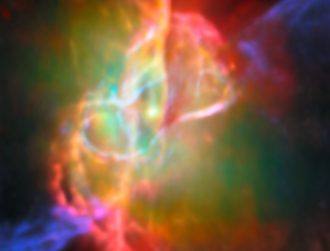Science
Webb Telescope Reveals Secrets of Butterfly Nebula’s Glow

The James Webb Space Telescope has made a groundbreaking discovery regarding the Butterfly Nebula, a prominent planetary nebula located approximately 3,400 light-years away in the Scorpius constellation. For the first time, scientists have pinpointed the location of the nebula’s central star, revealing new details that enhance our understanding of this stunning celestial object.
Observations from Webb have provided a “never-before-seen” portrait of the Butterfly Nebula, according to researchers. This nebula, which exhibits a striking structure resembling butterfly wings, is classified as a bipolar nebula. It features two lobes that extend in opposite directions, creating a distinctive shape that diverges from the round appearance of many other nebulas.
The term “planetary nebula” is somewhat misleading, as it pertains to stars rather than planets. The designation originated centuries ago when early astronomers noted the rounded appearance of these objects. In reality, planetary nebulas form when stars with masses between 0.8 and 8 times that of the Sun expel most of their material at the end of their life cycles. These nebulas are relatively short-lived, existing for only around 20,000 years.
Utilizing the Mid-InfraRed Instrument (MIRI), the Webb telescope captured detailed images of the nebula’s core. This advanced camera operates across various wavelengths, allowing scientists to observe how the appearance of the nebula changes at different light frequencies. Additionally, the research team supplemented Webb’s observations with data from the Atacama Large Millimeter/submillimeter Array, identifying nearly 200 spectral lines that provide insights into the atoms and molecules present in the nebula.
One of the most significant findings is that the central star of the Butterfly Nebula is encircled by a previously undetected heat dust cloud. This cloud emits a bright glow at mid-infrared wavelengths, facilitated by the star’s extreme temperature of 220,000 Kelvin. This makes it one of the hottest known central stars in any planetary nebula in the Milky Way, and it is this intense stellar energy that contributes to the nebula’s distinctive illumination.
In another intriguing development, the Webb telescope detected light emitted by carbon-based molecules known as polycyclic aromatic hydrocarbons (PAHs). On Earth, PAHs are commonly found in substances like campfire smoke, car exhaust, and burnt food. The detection of PAHs in the Butterfly Nebula may represent the first evidence of their formation within an oxygen-rich planetary nebula, marking a significant advancement in our understanding of these complex chemical processes.
Earlier this month, a separate study led by the University of St Andrews and utilizing the James Webb Space Telescope suggested the possibility that free-floating planets could develop miniature planetary systems independently of a star. These findings highlight the ongoing importance of the Webb telescope in expanding our knowledge of the universe and its myriad phenomena.
As researchers continue to analyze data from the Butterfly Nebula, the implications of these discoveries may reshape our understanding of stellar evolution and the life cycles of stars. The James Webb Space Telescope remains at the forefront of astronomical research, offering unprecedented insights into the cosmos.
-

 Entertainment2 weeks ago
Entertainment2 weeks agoAndrew Pierce Confirms Departure from ITV’s Good Morning Britain
-

 Health4 months ago
Health4 months agoNeurologist Warns Excessive Use of Supplements Can Harm Brain
-

 Health4 months ago
Health4 months agoFiona Phillips’ Husband Shares Heartfelt Update on Her Alzheimer’s Journey
-

 Science2 months ago
Science2 months agoBrian Cox Addresses Claims of Alien Probe in 3I/ATLAS Discovery
-

 Science2 months ago
Science2 months agoNASA Investigates Unusual Comet 3I/ATLAS; New Findings Emerge
-

 Entertainment1 week ago
Entertainment1 week agoGogglebox Star Helena Worthington Announces Break After Loss
-

 Entertainment1 month ago
Entertainment1 month agoTess Daly Honoured with MBE, Announces Departure from Strictly
-

 Science2 months ago
Science2 months agoScientists Examine 3I/ATLAS: Alien Artifact or Cosmic Oddity?
-

 Entertainment3 months ago
Entertainment3 months agoLewis Cope Addresses Accusations of Dance Training Advantage
-

 Entertainment5 months ago
Entertainment5 months agoKerry Katona Discusses Future Baby Plans and Brian McFadden’s Wedding
-

 Science2 months ago
Science2 months agoNASA Investigates Speedy Object 3I/ATLAS, Sparking Speculation
-

 Entertainment5 months ago
Entertainment5 months agoEmmerdale Faces Tension as Dylan and April’s Lives Hang in the Balance









